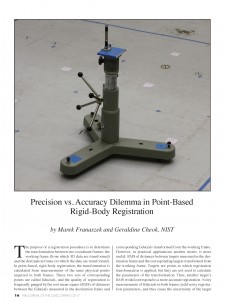
|
Download Members: $0.00 Non‑Members: $75.00 |
Buy Now |
Publication Details
| Published Date: | |
|---|---|
| Authors: | Marek Franaszek, Geraldine Cheok |
| Company: | CMSC |
| Print Format: | Technical Paper |
| Citation: | Marek Franaszek, Geraldine Cheok, "Precision vs. Accuracy Dilemma in Point-Based Rigid-Body Registration," The Journal of the CMSC, Vol. 12, No. 1, Spring 2017 |
Abstract
The purpose of a registration procedure is to determine the transformation between two coordinate frames: the working frame (from which 3D data are transformed) and the destination frame (to which the data are transformed). In point-based, rigid-body registration, the transformation is calculated from measurements of the same physical points acquired in both frames. These two sets of corresponding points are called fiducials, and the quality of registration is frequently gauged by the root mean square (RMS) of distances between the fiducials measured in the destination frame and corresponding fiducials transformed from the working frame. However, in practical applications another metric is more useful: RMS of distances between targets measured in the destination frame and the corresponding targets transformed from the working frame. Targets are points to which registration transformation is applied, but they are not used to calculate the parameters of the transformation. Thus, smaller target’s RMS would correspond to a more accurate registration. Noisy measurements of fiducials in both frames yield noisy registration parameters, and they cause the uncertainty of the target measurepoint transformed to the destination frame to be larger than the uncertainty of the target measured in the working frame. The increased uncertainty of transformed targets can be used as a measure of registration precision: Smaller increases correspond to more precise registrations. In this article, we show that the precision and accuracy of the registration depend on the location of the fiducials for the general case where the noise is nonhomogeneous, anisotropic, and the 3D data contain a bias. The obtained experimental results indicate that the configuration of fiducials that yields a more accurate registration does not necessarily yield a registration that has a small uncertainty, and vice versa: The configuration that yields small uncertainties of the transformed targets does not necessarily result in accurate registration.





